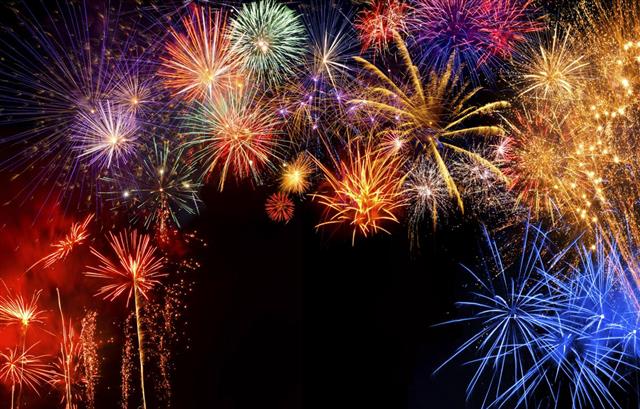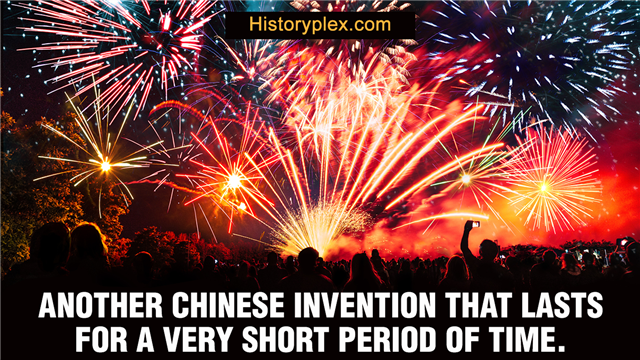
Fireworks are synonymous with celebrations, and we have Ancient China to thank for this. China is recognized as the birthplace of fireworks, which form an integral part of most of the Chinese festivals and traditions. This article tells you more about the legends and the history associated with the invention of fireworks.
China is credited for some of the greatest inventions of all time. Apart from the compass, papermaking, printing, tea, acupuncture, silk, and umbrella, China is also known for the invention of gunpowder — the forerunner of modern fireworks. The gunpowder was cited as a significant discovery and was one of the ‘Four Great Inventions’ by the Chinese.
Many legends are associated with the discovery of fireworks and gunpowder, so the exact date of their invention remains a mystery. Let us go back in history to learn more about the invention of fireworks, and how they went on to add different dimensions to celebrations and war.
The Inception

It is considered that fireworks originated in China during the Han Dynasty (206 BC-220 AD) to frighten and ward off evil spirits. The people in the Han Dynasty threw bamboo stems into a fire to produce a loud bang. The stems burnt and crackled in the fire, and later burst with a huge explosion. Bamboo has hollow air pockets, which inflate and burst with a big sound when subjected to heat.
This was an exciting experience for the Chinese. They strongly believed in the existence of evil spirits and thought that the sound of this explosion was loud enough to scare the spirits off. Getting rid of the evil forces was a sign of happiness, and so bursting of bamboos became closely associated with joy and celebrations. From then on, the Chinese traditionalized this concept of ‘bursting bamboos’ to fend off ghosts and spirits every year.
Later on, the bursting of bamboo formed a part of celebratory events, like the New Year’s Eve, weddings, parties, etc. This continued for quite some time until the discovery of the ‘gunpowder’. Gunpowder was later filled into the hollow bamboo tubes to explode with force, producing a loud sound.
History of Fireworks – Legends and Stories

According to a Chinese legend, the invention of fireworks is attributed to a Chinese cook. The cook accidentally mixed three ingredients, namely charcoal, sulfur, and potassium nitrate (the composition that was later used in gunpowder) and derived a black, flaky concoction.
When this mixture was ignited, it blew up and emitted a beautiful assortment of colors. Further experiments revealed that when this mixture was stuffed inside a bamboo shoot and ignited, it exploded with a very loud bang.
Many stories from the Tang dynasty (618-907 AD) credit a Chinese monk, Li Tian of Liuyang, in the Hunan Province, for the invention of the early fireworks. In one incident, Li Tian warded off a dragon’s pestering evil spirit by igniting bamboo shoots containing some explosive substance. The bamboo shoots burst with a loud explosion, which scared the dragon’s spirit away.
According to another legend, during the Zhenguan period in the Tang Dynasty, the east Hunan Province was hit by floods and droughts every year. Li Tian set off his fireworks in the inflicted area and dispelled the evil spirit that was supposedly causing the floods and droughts. Thereafter, the people in the Hunan province lived in peace and prosperity.
Impressed by this feat, the people of Liuyang named Li Tian as the ‘Founder of Crackers’. Not only that, they also built a temple in his name and started worshiping him. On the 18th of April, every year, the Chinese honor Li Tian by offering sacrifices.
The history of fireworks has its roots in Liuyang, in the Hunan Province of China. It is known as ‘The World’s Capital of Fireworks’, and is a major center of ‘Firework Production’ in China. China is considered to be the largest manufacturer and exporter of fireworks in the world.
The fireworks of today contain pyrotechnic compositions, which are classified as explosive materials, by the Bureau of Alcohol, Tobacco, Firearms & Explosives (ATF). It’s believed that the first ever pyrotechnic composition was discovered during the Sui and Tang Dynasties (581-907 AD). Records show that it was discovered by the Chinese alchemists who experimented with combinations of various substances to discover the ‘elixir of life’, a medicine that would ensure longevity or even immortality.
The combination used was a mixture of saltpeter and sulfur; however, alchemists in the Tang Dynasty used a mixture of saltpeter, sulfur, and carbon to discover their ‘elusive elixir’. When this mixture was heated, it exploded with a very huge intensity. The mixture was named ‘huo yao’, ‘fire chemical’, or ‘gunpowder’ by the alchemists. Later, they found that igniting bamboo shoots filled with this mixture produced a loud sound.
The alchemists could not discover their ‘elixir’, but their experiments were the driving force behind the invention of gunpowder. Their mixture was not as powerful as modern gunpowder as it did not contain sufficient amount of saltpeter (about 50%) to be explosive, but it was highly flammable. The modern gunpowder composition contains 75% potassium nitrate, 10% sulfur, and 15% carbon.

The Chinese carried out subsequent experiments with the gunpowder-filled bamboo tubes, that were open at one end. They attached these tubes to long arrows, which were launched from a stand of bamboo sticks. When ignited, these tubes launched themselves with great force and produced a thrust.
This was how the rocket came into existence.The Chinese used this rocket during the Mongol conquest in the 13th century to fight off the invaders. Hence, gunpowder found its applications in warfare.
Later, paper tubes were used to make firecrackers instead of bamboo stems. Stiff and small paper tubes were filled with gunpowder and fuses were inserted. When the fuse was lit, it ignited the gunpowder, causing the tube to explode.
Now, pallets are also used to hold the firecrackers together, so that when one is ignited or set off, it lights all the others, producing a series of fireworks in succession. Even today, firecrackers are made in China and exported around the world.
Since the inception of fireworks in ancient China in the 7th century, they have undergone a sea change. The earlier firecrackers had traditional connotations to it, and were used to frighten evil spirits. Now they are used for celebrations and even in war.
Fireworks Around the World
The invention of Chinese fireworks soon got noticed by the world travelers and spread far and wide. It is believed that the knowledge of gunpowder spread to the Middle East from China, possibly through India. The Arabs called potassium nitrate (saltpeter) as ‘Chinese Snow’, fireworks as ‘Chinese Flowers’, and rockets as ‘Chinese Arrows’ owing to the fact that they were Chinese inventions.
While some sources credit Marco Polo for introducing gunpowder and fireworks in Europe during the 13th century, others mention that the crusaders were responsible for it. More than developing firecrackers for entertainment, the Europeans were interested in manifesting the prowess of gunpowder in warfare. Hence, gunpowder was used in guns, canons, and rockets.
The two European countries which aced in the optimum use of gunpowder were Italy and Germany. Germany delved much deeper into the scientific aspect and developed scientifically advanced firecrackers.
The Italians were the first Europeans to use gunpowder for manufacturing fireworks. Italy pioneered the design of aerial shells, which on ignition, shot up towards the sky and burst with beautiful colors and effects.
In England, fireworks gained immense popularity during the time of Queen Elizabeth I. Some of William Shakespeare’s works mention that the Queen was so enchanted and impressed with the fireworks that she created a new position in her palace, that of the ‘Fire Master of England’.
The first celebration in America’s history that made use of firework displays was on the 4th of July, 1777, the American Independence Day. The inauguration ceremony of George Washington as the first President of the United States of America, also had an elaborate display of fireworks. Even today, fireworks are popular in the United States, and these displays form a part of many celebratory events, like the New Year.
The discovery of fireworks led to the invention of the early rockets, which were used by the Chinese in military and war, which developed further to be used as a destructive weapon later in wars. The Chinese monk Li Tian would have never thought that his pyrotechnic invention could open up a whole new realm of discovery. This simple discovery has shaped the history of mankind like no other invention.
Even today in China, firework displays form an important part of many celebrations and cultural events, like the Chinese New Year, to scare off spirits and welcome the new year with happiness and joy in everyone’s life. Eventually, fireworks spread to different cultures and societies around the world and have become an integral part of celebrations, victories, and joyous occasions. The recent developments in the fireworks industry and pyrotechnics have made musically-synchronized firework displays a huge success.




